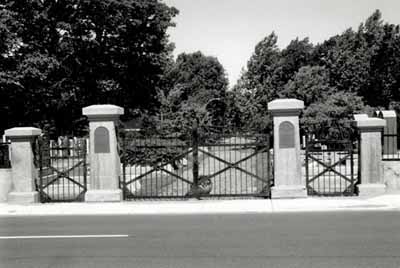Beth Israël Cemetery National Historic Site of Canada
Québec, Quebec

General view
© Agence Parcs Canada / Parks Canada Agency, 1991.
Address :
On René-Lévesque Boulevard Ouest, near du Bon Air Avenue, Québec, Quebec
Recognition Statute:
Historic Sites and Monuments Act (R.S.C., 1985, c. H-4)
Designation Date:
1992-06-10
Dates:
-
1840 to 1858
(Construction)
-
1894 to 1894
(Significant)
Event, Person, Organization:
-
Congregation Beth Israel Ohev Sholem
(Organization)
Other Name(s):
-
Beth Israël Cemetery
(Designation Name)
-
Beth Israel Cemetery
(Other Name)
Research Report Number:
1992-008, 1992-OB-01, 2009-CED-SDC-032
Plaque(s)
Existing plaque: Corner of Géronce-Gariepy and de Bellevue Streets, Québec, Quebec
A distinctive cultural landscape, this cemetery, with its tight straight rows, sequential plot usage and simple headstones, offers striking visual evidence of the Jewish belief that in death all are equal. Individuals are identified by Hebrew inscriptions and ancient religious symbols. Consecrated in the 1850s, the cemetery with its burial society building was ceded to the Congregration Beth Israel Ohev Sholem in 1894. It stands today as a tangible reminder of the pioneer Jewish community founded in 1759.
Description of Historic Place
Beth Israël Cemetery National Historic Site of Canada occupies approximately one acre of land in an area that marks the transition between the commercial and residential sections of the city and of the campus of Laval University, in the Sainte-Foy-Sillery district of the City of Québec. The cemetery is rectangular in shape and is protected by a low stonewall topped by an iron railing along René-Lévesque West Boulevard and a snow fence along its other three sides. The cemetery’s layout is simple, with trees and shrubs, two walkways traversing the property and a funeral home. The site is characterized by the spatial organization of 300 or so tombstones, of simple and discreet design, that bear Hebrew inscriptions and are arranged closely together in linear rows. There are also numerous distinctive religious symbols, specifically relating to the Jewish faith. Official recognition refers to the legal description of the site.
Heritage Value
Beth Israël Cemetery was designated a national historic site of Canada in 1992 because: by virtue of its age, its burial house, its linear spatial arrangement, its grave marker design and its range of Jewish religious symbols, Beth Israël Cemetery, in Québec, provides an excellent representative example of a burial ground in the Jewish cultural tradition
Since the latter half of the 19th century, most members of the Jewish community in the City of Québec have been interred at the Beth Israël Cemetery. The cemetery remains as a rare witness to the founding of a community by the first Jewish settlers in the second half of the 18th century. Although the Jewish presence in the City of Québec had been long established, it was only in the mid 19th century that the community grew large enough to found a congregation. Between 1840 and 1858, the property was purchased by a Jewish merchant, consecrated and then transferred to the Beth Israel Ohev Sholem congregation in 1894.
The cemetery contains about 300 headstones arranged closely together in straight lines. This spatial organization is characteristic of all known Jewish graveyards, and has its origins in the Judaic belief that burial is the only sanctioned way to lay a person to rest. Consequently, the space in a Jewish cemetery has always been accorded great value and must not be wasted. Of equal importance is the profound conviction that in death all humans are equal. Once inside a cemetery, all social distinctions are erased and there are no preferred or reserved sites. The rules governing the layout of the cemetery also apply to the design of the markers. The majority of Jewish graves are marked by simple, discrete stones and it was only in the late 19th century that markers in the Greek Revival style, including obelisks, columns and broken columns, were erected. Most plots in Beth Israël Cemetery are bounded by retaining masonry walls, allowing for the lots to be elevated above ground-level.
Source: Historic Sites and Monuments Board of Canada, Minutes, June 1992.
Character-Defining Elements
Key elements that contribute to the heritage character of the site include: its location in the Sainte-Foy-Sillery district of the City of Québec; its boundaries that are defined by a low stone wall topped with an iron railing along René-Lévesque West Boulevard and by a snow fence on the other three sides; the simple layout with trees and shrubs, and the two gravel walkways that traverse the property; the spatial organization of the gravestones in straight and closely spaced rows, typical of Jewish cemeteries; the gravestones of simple and discrete form and style, with Hebrew inscriptions; the numerous Judaic symbols, including Sabbath candelabras with varying numbers of branches, blessing hands, the jug and bowl, the lion, holy books and the Star of David; the retaining masonry walls around the plots and the cast iron or masonry fences surmounting the walls; the funeral home on the site.